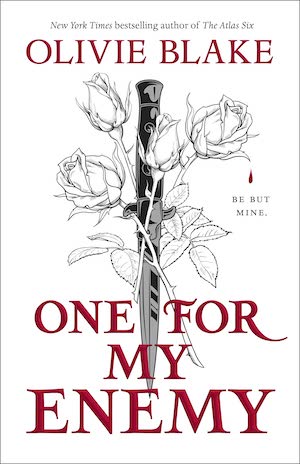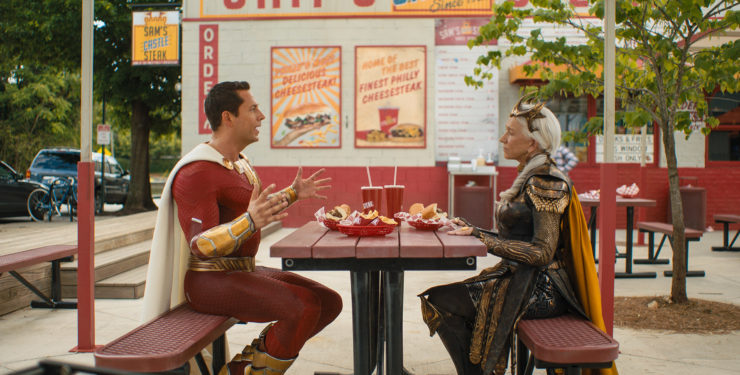It’s been four years and a lot of growing up for the Shazam family (Shazam Fam? ShaFamily? Zamily?), but despite the recent shakeup with the DC film universe and its incoming Gunn-ification, we still have this sequel to contend with. Is it awkward trying to find the middle ground that Shazam and company occupy while its parent studio chucks millions of dollars in multiple directions that will likely never touch what we’re seeing here?
I mean, yeah. That’s really only one piece of the problem, though.
[Spoilers for Shazam! Fury of the Gods]
Remember in the last film when Billy broke that fancy staff in half at the end of the fam’s super fight with Dr. Sivana? (It’s okay if the answer is no, the film will remind you.) Well, that turns out to be a mistake for the sequel, leading to a splinter between realms and the unleashing of the Daughters of Atlas. The trio—yes, there are three despite the film only showing us two to begin with, and the reveal of the third sister being particularly obvious down the line—are angry over being trapped in a dying realm for centuries and mean to rebuild with a seed. Unfortunately, some of them are more bent on revenge for their imprisonment than others….
As this side of the tale builds steam, there’s more trouble at hand on the superhero side of things; Billy’s family isn’t as excited to band together and save the city as they once were, Freddy (Jack Dylan Grazer) keeps nipping off for solo missions in the middle of the night, and Billy (Asher Angel) is panicking over the fact that he’s about to age out of the foster system and will then become a “burden” to the Vasquez family if he stays in their home. This fear is only heightened by sister Mary (Grace Caroline Currey), who projects many of her own fears onto Billy having already reached that age-out point herself—she’s neglected to go to college to continue aiding the super fam (because Philadelphia doesn’t have local colleges, apparently), but also has a job so that she can contribute money to the household.
Buy the Book


One for My Enemy
This is where things get hairy, as the sisters are looking for their seed and expecting to encounter serious champions guarding the Earth, the kids are hiding their super-antics from their parents and a city that is less appreciative than it should be, and growing pains abound. And it’s… fine? Mostly just fine, though. It’s hard to be more excited than that.
If we’re going to delve, there are several logic gaps in the film that might pull a person straight out because they’re goofy enough to prove distracting. For one, Mary no longer has an “adult” super persona when she shazams… presumably because she’s over eighteen? The spell seems to account for that? Which is weird because eighteen definitely wasn’t the coming-of-age number in ancient times when the power was forged by the wizard, right? By this logic, Billy will only be aging up as Shazam for another half year, which is likely not the plan. Letting that go, let’s zoom in on the really obvious issue that pops up often in “high school” films and makes even less sense as time goes on—Freddy gets beat up by two school bullies in the hall toward the start of the film, and a teacher suddenly appears to break up the scene… but nothing happens aside from a glare and sympathy from said teacher. Because in high school, it’s completely okay to assault a disabled student provided he’s still tossing off quippy one-liners about it.
All of this is made more awkward still by the same problem we had in the first Shazam movie—namely that Zachary Levi (as the titular hero) and Asher Angel seem to be playing two completely different versions of Billy Batson. And it’s a shame because Angel’s take on Billy is far more endearing than anything Levi is putting on, and more nuanced to boot, whereas Levi’s iteration relies on nothing but babbling, posturing, and teen clichés to keep it afloat. As a result, it becomes easy to hope the story will find reasons to depower Shazam just for the sake of seeing the more emotionally-competent actor play the character. It’s also jarring for the fact that none of the other adult actors playing the shazamed kids overdo it in the same way; they’re all perfectly on-point being just a little more exuberant or awkward, and allow those choices to speak volumes.
There are deeper emotional thoughts at play in the story that never see the light of day. We have Billy’s fears and Mary’s paralysis, and we even have Freddy’s journey to discover his own internal strength—but the film isn’t subtle enough to handle any of these journeys with the consideration they’re due. The difficulty Freddy has in using his superpower as a means of getting around his disability doesn’t stack because it’s clear that no one writing the script can conceive of the thought that disability doesn’t automatically lead to self-hatred. At one point Freddy insists that he’s “broken” and the powers are a way to distract from that, yet while the film gives him the chance to prove that he’s strong in other ways, it never once considers that Freddy might view his differently-abled body with any emotion other than loathing. There’s also no indication that Freddy feels any broader anger toward his society or even his peers for treating him poorly, which hampers the film’s chances at a more complex depiction.
It’s relevant, too, that for all the troubles going on in the Vasquez household, it’s the three white foster kids who get the most narrative focus and character development. Continuing that thought, it’s also relevant that while Billy finally gets closure from foster mom Rosa (Marta Milans) about his fear of burdening the family, Mary gets none of the same closure. But that’s hardly surprising when you take the broad view of the way that the two Shazam films have depicted women, or, more specifically, how they frame women who are worthy and heroic. It’s notable that all “good” women in these films are mothers or maternal in a broad world-tending sense, and aspire to provide for others (Rosa, Mary, Wonder Woman, and even Helen Mirren’s Hespera by the end), while all “bad” women eschew maternal feeling and are focused on feelings of fear or vengefulness (Billy’s biological mother, Lucy Liu’s Kalypso).
And age plays a factor in how these character’s are handled as well; in Fury of the Gods, the Daughters of Atlas are predictably cast with an eye toward the Maiden-Mother-Crone dynamic, with all of the sisters being relatively the same age (six millennia give or take a few years), but appearing either young (Rachel Zegler’s Anthea), middle-aged (Kalypso), or old (Hespera) according to that template.
Guess which sister is the “good” one?
Good job guessing Anthea. (And, of course, it’s entirely fine for her to date Freddy and for Billy to want to date Wonder Woman because their foster parents give appropriate side-eye over their sons being into “older” women. Because we’re still making this joke, for some reason.)
And yes, the film has its moment of joy and affirming delight, like Darla insisting on becoming the leader of a goth unicorn army, or Steve the sentient pen, or Pedro’s coming out. (As usual, Djimon Hounsou is criminally underused.) It’s great that Billy’s family have to fight for the city of Philadelphia as non-powered kids in the film’s climax, avoiding many of the pitfalls the first film suggested about having a “ideal” super form in order to be a hero (though I’m still at a loss about how anyone is riding mythical equine creatures bareback). It’s just unfortunate that the bigger messages aren’t being given more thought—particularly in a film that’s meant to inspire children.
Shazam!, as before, is cute… but the instant you stop to think about it, the whole thing comes apart.
Emmet Asher-Perrin doesn’t believe they’re going to make a third Shazam fam film. They’ll believe it when they see it. Hopefully we don’t get a Batman cameo? That seems like the next logical one, but it would just be so awkward. Send Robin instead. You can bug them on Twitter and Tumblr, and read more of their work here and elsewhere.










